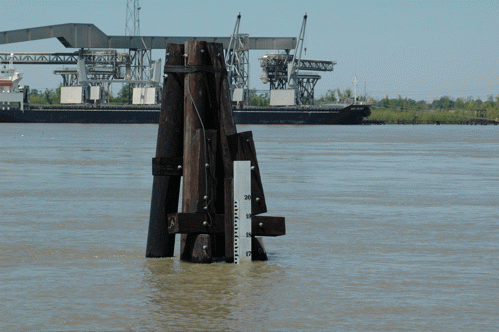Water stalks southern Louisiana like a panther seeking its prey. Hurricane Katrina was the kill, but the water never relents—always moving, sometimes retreating, forever on the move. This week the National Weather Service issued a flood warning for New Orleans as record snow melts and spring rains flowed into the Mississippi River Basin. Feeding on strong northerly winds that carried record cold into the delta, rapid river crests are expected north of Baton Rouge in Greenville and Vicksburg. The choreography of the hunt reached perfection with a southerly shift in the winds and increased tidal flow in New Orleans, pushing and squeezing the water to “official” flood stages.
On Tuesday April 15, the Carrollton gauge at the Army Corps of Engineers office on Leake Avenue in midtown was inching toward 16.5 feet. New Orleans has an official flood stage of 17 feet, but the floodwalls and levees protect the city to over 20 feet, providing the winds and the rain and the flow cooperate.
In St. Mary Parish where I live today, minor flooding has occurred on the waterfront in Morgan City because of rising water in the Atchafalaya. So far so good, and the floodgates are keeping the worst of the water out of the infrastructure. The Atchafalaya is expected to crest on April 22. We will see. This writer loves this place and the people here make me feel at home. I’m here for the duration to tell their stories. Parts of this article were published in the Huffington Post, but OPED feels like home, so I wanted to share this story with all of you. Plus, these people can use all the help and attention we can muster.
There is a “pretty” video about the port, that is industry public relations, available here. Still, use critical thinking when you view this and you will get a good idea of how the United States relies upon this port and how the people here are terribly exploited. I think I like living here because I am in a state of permanent culture shock and it truly reminds me of the third world. To put it simply, I am in love with this area as much as I love Africa.
The Corps of Engineers caught a lot of flack in the aftermath of Katrina, but there is another story of regular men and women doing a day to day job of maintenance and observation that gets overlooked in the flurry of media attention to the disaster—meaning the disaster that was Katrina—an epic victory for the water which will forever haunt this area. Attention spans are short, both in the halls of Congress and in the mainstream media—but the water does not yield.
Chris Accardo’s office overlooks the Mississippi and the Carrollton flood gauge. Forty one percent of the nation’s water flows past his window. Only the mighty Amazon and Congo Rivers have bigger watersheds. It’s his job, as Chief of the New Orleans District Operations to make sure that the spring water flow does not exceed 1.25 million cubic feet per second. For some perspective on what that amount of flow means—it would fill the Super Dome in one minute and forty seconds, according to published estimates. Accardo’s fallback for now is the Bonnet Carre' Spillway, which has an elaborate system of floodgates. As of April 16, 90 gates are open now, with more in reserve.
This is the first time in eleven years that Bonnet Carre’ was asked to do her job. The spillway is located 28 miles above New Orleans in St. Charles Parish. It was designed to manage approximately 1.9 million gallons of water per second. The decision to open Bonnet Carré is the responsibility of Mississippi River Commission.
Major Tim Kurgan, Corps media rep for the New Orleans’ office, joined us for a conversation about the levee system, what’s happening real time with the water flow, and the competing interests, which make flood management a decidedly dicey proposition.
There are actually two levee systems that protect human interests from nature’s predation. The river levees, designed for high river events, held during Katrina, and have always held. They are expected to hold now, during what is expected to be a ten-year very high water event, albeit one that is spooking the area less than three years post Katrina.
Accardo is confident, but not cocky.
“We expect to be able to deal with this high water event and respond to any problems that may arise,” he says.
“Louisiana was given billions for hurricane protection after Katrina, but those funds were for hurricane protection levees. The levees that we are relying upon for high river events are not covered by that money. The river levees are in better shape than the hurricane protection levees, and therefore do not require the amount of funds as the hurricane protection system.”
“Northern Congressmen don’t understand that we have two systems of levees down here. They don’t want to keep throwing money down here when they have constituents up in their districts who have other projects in mind,” Accardo added as his eyes scanned the expanse of river a hundred feet outside of his windows.
Accardo and Kurgan talked about a maintenance budget for the river levees that is essentially “flatlined.” How did this happen?
(Note: You can view every article as one long page if you sign up as an Advocate Member, or higher).






